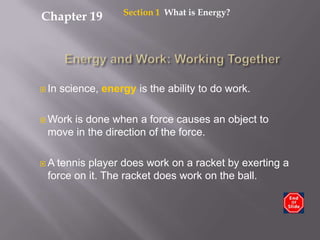
Unit 3 pp #1 7th grade
- 1. Section 1 What is Energy? Chapter 19 Energy and Work: Working Together In science, energy is the ability to do work. Work is done when a force causes an object to move in the direction of the force. A tennis player does work on a racket by exerting a force on it. The racket does work on the ball.
- 2. Section 1 What is Energy? Chapter 19 Energy and Work: Working Together, continued When one object does work on another, energy is transferred from the first object to the second. This energy allows the second object to do work. So, work is a transfer of energy.
- 3. Section 1 What is Energy? Chapter 19 Energy and Work: Working Together, continued Like work, energy is expressed in units of joules (J). There are many different kinds of energy, and all can be measured and compared.
- 4. Section 1 What is Energy? Chapter 19 Kinetic Energy Kinetic energy is the energy of motion. All moving objects have kinetic energy. Kinetic energy can be used to do work. For example, kinetic energy allows a hammer to work on a nail.
- 5. Section 1 What is Energy? Chapter 19 Kinetic Energy, continued Mass and Speed The amount of kinetic energy that a moving object has depends on the object’s mass and speed. The faster an object is moving, the more kinetic energy it has. The more mass an object has, the greater its kinetic energy.
- 6. Section 1 What is Energy? Chapter 19 Kinetic Energy, continued Speed has a greater effect on kinetic energy than mass does. A truck with twice the mass of a car but moving at the same speed has twice the amount of kinetic energy. But if the speed of the car doubles, its kinetic energy increases by four times.
- 7. Section 1 What is Energy? Chapter 19 Potential Energy Potential energy is the energy an object has because of its position. For example, a stretched bow has potential energy because work has been done to change its shape. The energy of that work is turned into potential energy.
- 8. Section 1 What is Energy? Chapter 19 Potential Energy, continued Gravitational Potential Energy When you lift an object, you are doing work on it. You use a force that is working against the force of gravity. So, when you lift an object, you transfer energy to it and give it gravitational potential energy.
- 9. Potential Energy Section 1 What is Energy? Chapter 19
- 10. Section 1 What is Energy? Chapter 19 Potential Energy, continued Books on a shelf have gravitational potential energy. The amount of gravitational potential energy an object has depends on its weight and height. Higher and heavier objects have greater gravitational potential energy.
- 11. Section 1 What is Energy? Chapter 19 Mechanical Energy Mechanical energy is the total energy of the motion and position of an object. Both potential and kinetic energy are types of mechanical energy. Mechanical energy can be made up of only potential energy, only kinetic energy, or some of each.
- 12. Section 1 What is Energy? Chapter 19 Other Forms of Energy All matter is made of particles that are always in random motion. Thermal energy is all of the kinetic energy due to the random motion of particles that make up an object. Thermal energy is often measured by measuring temperature.
- 13. Section 1 What is Energy? Chapter 19 Other Forms of Energy, continued All matter also has chemical energy. Chemical energy is energy stored in chemical bonds. It is a form of potential energy. The energy in food is stored as chemical energy.
- 14. Section 1 What is Energy? Chapter 19 Other Forms of Energy, continued Electrical energy is the energy of moving electrons. Sound energy is energy created by an object’s vibrations. In an amplifier, a vibrating cone causes air particles to vibrate. These vibrating particles transmit sound energy to your ear.
- 15. Section 1 What is Energy? Chapter 19 Other Forms of Energy, continued Light energy travels in waves called electromagnetic waves. Electromagnetic waves can be produced by the vibration of electrically charged particles. Some light energy can be seen. Other kinds, such as microwaves and ultraviolet light, can’t be seen by the human eye.
- 16. Section 1 What is Energy? Chapter 19 Other Forms of Energy, continued Nuclear energy is the energy that comes from changes in the nucleus of an atom. The sun’s light and heat come from fusion reactions, when hydrogen nuclei join to make a helium nucleus. Without nuclear energy from the sun, life would not exist on Earth.